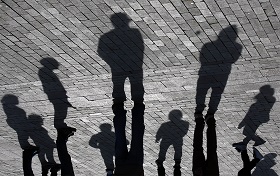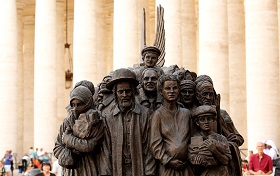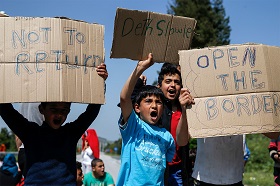Far-Right Vigilantes
Pegida supporters
In
Login if you are already registered
(votes: 5, rating: 5) |
(5 votes) |
Postgraduate student, IMEMO RAS
In 2015, Europe faced a dramatic spike in the influx of refugees and illegal immigrants, the biggest since WWII. Migrating to the world’s most developed regions in search of a better life has always been an understandable and natural phenomenon. It cannot be denied that it also has an illegal dimension: some flee poverty without thinking about paperwork, some evade criminal prosecution in their homeland, some want to reunite with their families, and few think about learning the language, culture, laws and history of the host countries. There is another problem: many refugees spontaneously leave their countries in an emergency. The Refugee Convention dictates a favourable attitude to them, as well as providing them with legal and material aid. Refugees would appear to be able to stay in their new country for good: they cannot be deported due to considerations of humanity (with the exception of “compelling reasons of national security”), and once the emergency is over, there is no particular desire to go back to one’s home (even a destroyed one).
Vast numbers of new arrivals are hard to assimilate, it is easier for them to move in with their compatriots who arrived earlier, and live on welfare. This prompts discontent among the locals and could cause a recession. This situation is hard to manage, and it can quickly become unmanageable: and vigilant public order squads run the risk of turning into storm troopers who no longer expect help from the police. Attacks on refugee centres and mosques happened before, but they were carried out by fringe groups of local thugs from among local troubled youth. Yet exacerbation of the immigration situation provides fertile soil for extreme right-wing parties that do not look deep into the reasons for immigration, into refugees’ social problems, and lump all people of non-European origin together, no matter what education they have and what work they do.
The current immigration crisis in Europe was caused by a sharp, massive influx of people from other cultures and the inability to "digest" this influx rapidly created room for uncompromising rhetoric that is simple and easy to understand. Nationalist parties propose a quick response to any sudden phenomena without looking deeply into its causes and without thinking about the consequences, and their popularity is growing sharply in those states that have suffered most in the immigrant crisis. Even so, elections are held only once in several years whereas ethnic hostility is manifested daily. The increase in anti-immigrant crime shows that ordinary people are not going to wait until new members of parliament take office. The most dangerous thing happening is that people who have never before seen themselves as nationalists are now joining the process of resolving the immigration problem with the help of those very nationalistic bodies (of varying degrees of radicalism and legality). Anti-EU and anti-immigrant sentiment (and this applies even to immigrants from previous generations) are already represented in Europe's parliaments, and ratings are growing, but not owing to their own appeal or the appeal of their political programmes. This is an expression of desperation and disappointment with the current immigration policy. This is a protest and a censure vote.
In 2015, Europe faced a dramatic spike in the influx of refugees and illegal immigrants, the biggest since WWII. Migrating to the world’s most developed regions in search of a better life has always been an understandable and natural phenomenon. It cannot be denied that it also has an illegal dimension: some flee poverty without thinking about paperwork, some evade criminal prosecution in their homeland, some want to reunite with their families, and few think about learning the language, culture, laws and history of the host countries. There is another problem: many refugees spontaneously leave their countries in an emergency. The Refugee Convention dictates a favourable attitude to them, as well as providing them with legal and material aid. Refugees would appear to be able to stay in their new country for good: they cannot be deported due to considerations of humanity (with the exception of “compelling reasons of national security”), and once the emergency is over, there is no particular desire to go back to one’s home (even a destroyed one).
Yet pressing issues emerge. Do refugees want to accept the laws and culture of the states that take them in or are they attracted by generous welfare payments? Is a specific individual a refugee or just an illegal immigrant who underhandedly joined the unmanageable flow? Finally, there is the cornerstone of all immigration-related disputes, the rather inconvenient question of whether the natives of host states need all this and, if they do, how many refugees are they ready to take in? And if they are very unhappy with the immigrants’ behaviour, for how long are they willing to bear it and how competent are the authorities in combating it? The events of the migration crisis (and such a powerful flow that cannot be taken in and distributed should already be called a crisis) in Europe demonstrate an increase in ordinary people’s negative attitudes, lack of new solutions to the migration problems, and some countries’ refusal to take in immigrants. Some people are beginning to handle this problem independently and not through talks. The authorities have labelled these vigilantes [1] the far-right.
Has it always been that bad?
In the first half of the 20th century, Europe saw significant migration stemming from raging wars, redefined borders and the collapse of empires. Yet this has all affected the people who have been living in Europe for centuries. In the 1960s-1970s, Western Europe, the engine of economic development, initially encountered migrants from Europe’s own least developed sub-regions. By the early 1990s, the states of Northern Europe that had implemented the Scandinavian “welfare state” model had also become recipient states. There is also a reverse movement: many people from the cold North prefer to move to the sunny South. For instance, British citizens have actively explored France, Spain and Cyprus. The Schengen Agreement is in force, and the EU is beginning to emerge. The European Union expands eastward, and its new members enjoy the benefits of free movement, while their citizens seek their fortune abroad.
The wealthiest part of the European continent also appealed to those who lived outside Europe. It all started with the former colonies: former metropoles needed labour force, their birth rates were falling, and the people of the newly-independent states had no language barrier. For instance, migrants from the Maghreb went to France, the Netherlands, Belgium, and West Germany and, in the 1980s, they also started moving to Italy and Spain. However, back then, there was work waiting for them, and they travelled legally, as labour migrants while, beginning in the 1990s, increasing numbers of people from less prosperous countries wanted to take advantage of the social state.
The Mediterranean was the main route for African immigrants: they crossed it on boats, but such journeys are risky, and there have been casualties. The Italian island of Lampedusa has suffered a lot: since 1998, it has been the main refugee acceptance centre; already in 2003, there were voices in the Italian government proclaiming a migration crisis. Back then, the figures of “over 2,500 refugees” a month seemed scary, while today, it is but a drop in the ocean. And for some people, it is business: smugglers’ assistance costs USD 2,000. Coping with the influx has been hard: Italy reached a secret agreement with Libya on sending refugees back, the EU criticised this step, the camp was overflowing, living conditions were grossly violated, the local population was becoming progressively anti-migrant.
The immigration statistics in the early 2010s were no more optimistic: North Africa and the Middle East were going through the Arab Spring, consisting of numerous protests, some of which resulted in coups d’état and civil wars. Between 2010 and 2013, about 1.3 million people migrated to the EU annually (not including asylum seekers). Yet migrants’ geography was rather diverse, spanning far-away from China, India and the US and nearby Russia, Ukraine, Moldova and Turkey. Later, the arrivals’ composition changed significantly, with the Middle East accounting for the majority of migrants. And the increased numbers of refugees in the Mediterranean resulted in a humanitarian disaster, with Italy having to use the military to receive migrants. Ultimately, 150,000 people were rescued.
The population of the states where the Arab Spring raged deserves special mention. These are mostly "young" people, few over 65 years old, and a high proportion of the employable population. For instance, one-third of Egypt’s population is under 14, the elderly accounting for 3–4%. Syria and Lebanon present a similar picture. In the 1970s and 1980s, Arab countries experienced a baby boom and falling mortality, which resulted in a demographic explosion and, today, these generations have grown up and are taking part in revolutions. Young hotheads see war around them, perceive extremist ideas as a clear-choice, “easy,” and “convenient” way of resolving all problems, and join armed groups. Scientific achievements of the civilised world have reduced mortality, while reproductive traditions remain the same, and no one is going to give up on them.
Previously, European states managed to cope with refugee flows, but the numbers of those wishing to settle in the EU without necessarily earning a living create an economic burden and prompt resentment among the local people: many immigrants are not eager to learn the language and find a job. Europeans looked around and saw whole neighbourhoods with an entirely immigrant population; they saw “Islamic patrols” in the UK and Germany. Far-right parties gain electoral support, while politicians currently in power speak about the threat to European values, yet invite more immigrants. Residents of Europe no longer understand whose side their governments are on and whether the governments are going to change the situation for the better.
Tolerance test: meeting the refugees
The worsening of the Syrian crisis reduced financing for refugee camps in Turkey, Jordan and Lebanon (at first Syrians fled there), and then a new route via Greece prompted a spike in refugee numbers: a million in 2015, nearly four times more than in 2014. The highest numbers seek asylum in Germany, Hungary, France, Italy, and Sweden. Yet the powerful migrant flow only split the EU states on the asylum issue. Countries began to reinstitute border controls or simply let people travel on to Germany, where refugees wanted to go in the first place. Hungary closed its borders, but physical obstacles did not stop refugees from seeking other routes via Croatia, Slovenia and Austria. North Macedonia and Bulgaria are strengthening their borders. The human flow reaches Austria, and Vienna, too, decided to erect a border fence. EU members quarrel over quotas: Eastern Europe does not want to take in refugees, Italy threatens to send its migrants north, Hungary and Austria continue to tighten border controls. When a common disaster strikes, European unity begins to show serious cracks.
Citizens did not particularly welcome immigrants. The eve of 2016 was particularly odious, when over 1,000 women in the west of Germany were harassed, and later it became known that the perpetrators were immigrants. Most attacks went unsolved, and Chancellor Angela Merkel even cancelled her Davos visit. German citizens responded with a rally, but everything ended in confrontation with the police. In addition to harassment, they were disconcerted by the police hiding information about the perpetrators and the number of victims. The “Refugees welcome” slogan was transformed into “Rapefugees not welcome.” The attitude to migrants in everyday life deteriorated rapidly, the problem lying not only in possible clashes, but in this attitude easily being extended to those who had immigrated to Europe, obtained citizenship and long been part of European society. This is a view of not just of today’s immigrants but all people of non-European origin. The difference in the mindset is significant, and the issue of vast numbers of refugees became a matter of European survival and how Europe would look in the future. The citizens themselves begin to take the immigration agenda into their own hands, even though previously it had been the purview of political parties reflecting, through representation, opinions on a particular issue and building state policies accordingly. If a problem becomes unmanageable, some individuals begin spontaneously participating in certain movements not represented at the top level.
PEGIDA
The movement was founded in Dresden back in late 2014: it started with a social network group criticising Germany's immigration policy. The first rally was held on 20 October 2014, followed by weekly marches. In December, the number of demonstrators reached 10,000 and, in January 2015, it climbed to 25,000. The protesters’ main slogans were “For the preservation of our culture”; “Against religious fanaticism”; “Against religious wars on German soil.” Germany had never previously had such a rapidly growing anti-immigrant movement. Before, it had been the prerogative of fringe right-wing groups, but now Germany’s middle class was speaking out against the country’s immigration policy. Various types of hoodlums are always around, but their threatening, anti-social behaviour would never have attracted such numbers. Owing to threats against the movement, the rallies were suspended and then resumed in October with 20,000 people attending. The movement’s information activities are concentrated on the Internet since mainstream German media do not broadcast such an agenda, which they immediately dubbed Nazi and chauvinist.
Despite accusations of populism and of attempts to overthrow the system of government, this method of protesting against the failed immigration policy demonstrates Germans’ tremendous self-possession and tolerance. These are not isolated radical groups attacking refugee centres but a regular declaration of will on a pressing issue, even if this declaration is made on the streets rather than through political institutions. Something similar has already happened in recent history: 30 years ago, weekly rallies were held in East Germany but, back then, people were demanding political freedoms. It resulted in the reunification of Germany, which is perceived in a positive light, while such a profoundly negative attitude to refugees is not approved of in Germany, which diligently conducts a policy of overcoming its Nazi past. Now PEGIDA is also accused of “appropriating” this freedom-loving spirit of 1989, and indignation over immigration is mixed with ethnic hatred of Hitler’s Germany. Thus far, German citizens choose rallies and voting: at the 2017 parliamentary elections, the nationalist Alternative for Germany (which cooperates with PEGIDA) came in third. The opposition to taking in higher numbers of immigrants remains high, at 72%.
Soldiers of Odin
This movement emerged a year after PEGIDA in the north of Europe, but it is not as large. In addition to rallies, its members patrol the streets and keep a record of crimes committed by immigrants. The first patrols appeared in Kemi, a border town in Finland where refugees from neighbouring Sweden arrived. As with PEGIDA, its groups coordinate their actions via social networks and expand their patrolling throughout the country. Its founder, Mika Ranta, was previously accused of a hate crime and cooperated with the far-right Nordic Resistance Movement. The patrols’ organisers claim that their objective is to provide voluntary assistance to the Finnish police in stopping crime, irrespective of the perpetrators’ ethnicity (such independent action is not prohibited in Finland). But they do not hide the fact that it was the harassment in Cologne that prompted them to patrol crowded areas (in particular, Soldiers of Odin said that immigrants chase girls near schools). Finnish law enforcement authorities treat such assistance with great caution and view these people not as patrols but far-right racist groups. Even so, the police are very reluctant to publish crime statistics and are very afraid of drawing parallels between increased refugee numbers and increased crime (in Finland’s statistics, natives of Afghanistan, Iraq, Syria and Turkey are among the leaders in sexual offences). In response, sales of pepper spray grew, new self-defence classes opened, rallies were held, and street patrols were implemented. That is the only way for citizens to convey their stance both to politicians and to the immigrants themselves. Soldiers of Odin have spread beyond Finland: newly-minted “public order squads” have been spotted primarily in Sweden, Norway and the Baltic states (in Oslo, immigrants responded with patrols of their own).
The Nordic Resistance Movement also deserves a brief mention. It is a radical right-wing organisation that cooperates actively with Soldiers of Odin. In Finland, this cooperation ended in the Resistance being prohibited, since its members, in addition to patrols and rallies, promulgated openly Nazi ideology and attacks on immigrants. Curiously, despite the small number of refugees, it was Finland that generated the anti-immigrant patrol trend. Members of these patrols often have a criminal record of hate crime or statements. Most Finns, Danes, Norwegians and Swedes believe that no more immigrants should be taken in.
Labour and education
Even so, refugees are a specific issue. People fled a humanitarian disaster and Europeans showed mercy to dispossessed people. The host countries responded with educational services since a large number of refugees do not even have a secondary education: 67% of refugees in Norway, 50% in Sweden (and only 4% attend school after being given a residence permit). Only 38.3% of immigrants in Germany have a professional or higher education (and that includes incomplete studies). Germany stands out with the biggest number of initiatives for immigrants in providing language training, seeking housing, providing medical services and scholarships. UNESCO estimates that only a third of sub-Saharan Africans have even an elementary education and only 1% of refugees receive higher education. The education problem is determined not only by a shortage of teachers (Germany needs an additional 42,000 teachers) but also by special requirements for professional training: the multicultural approach entails teaching students of different ages and with diverse linguistic backgrounds in overfilled classrooms. Expenditures on refugees are not perceived in a negative light: German economists see it as stimulating the economy by creating new jobs.
The new far-right base
Vast numbers of new arrivals are hard to assimilate, it is easier for them to move in with their compatriots who arrived earlier, and live on welfare. This prompts discontent among the locals and could cause a recession. This situation is hard to manage, and it can quickly become unmanageable: and vigilant public order squads run the risk of turning into storm troopers who no longer expect help from the police. Attacks on refugee centres and mosques happened before, but they were carried out by fringe groups of local thugs from among local troubled youth. Yet exacerbation of the immigration situation provides fertile soil for extreme right-wing parties that do not look deep into the reasons for immigration, into refugees’ social problems, and lump all people of non-European origin together, no matter what education they have and what work they do. This is the fight for the middle class, educated people with a stable income, who are good at counting their money and do not understand all the subtleties of the increased economic burden caused by refugees. Europe boasts the world’s biggest middle class: 194 million people in 2015. In percentage terms, this class is most visible in Belgium, Italy, the UK, Norway, Spain, the Netherlands and Ireland, with over 50% of these countries' population considered middle class. In France, Germany, Finland, Denmark, Sweden and Austria, this figure ranges between 40 and 50%. Yet the middle class prefers a stable income and lack of any radical shifts, while the desire for greater wealth is international.
After WWII, in addition to proscribing ethnic nationalism, civil nationalism was also being erased: European integration created new supra-national institutions and erased borders between states. Taking in refugees from regions far from Europe picked up pace in the 1990s, and it has gradually caused cracks to appear in intra-European relations: less affluent countries have been shifting immigration problems on to the more affluent ones. New EU members, formerly closed states with a small middle class, refuse to assume obligations to take in immigrants who need to be provided with housing, work and education. Naturally, political parties form a communications channel between the public and the authorities, and there are such parties that promote an anti-immigrant agenda. Still, this today translates into Euro-scepticism and nationalism, with each state not only wishing to be free from Brussels’ commands but also projecting the difficulties and privations stemming from taking in refugees on to all representatives of non-European peoples, even if they came earlier and were assimilated. The trouble is, the current immigration crisis in Europe was caused by a sharp, massive influx of people from other cultures and the inability to "digest" this influx rapidly created room for uncompromising rhetoric that is simple and easy to understand. Nationalist parties propose a quick response to any sudden phenomena without looking deeply into its causes and without thinking about the consequences, and their popularity is growing sharply in those states that have suffered most in the immigrant crisis. Even so, elections are held only once in several years whereas ethnic hostility is manifested daily. The increase in anti-immigrant crime shows that ordinary people are not going to wait until new members of parliament take office. The most dangerous thing happening is that people who have never before seen themselves as nationalists are now joining the process of resolving the immigration problem with the help of those very nationalistic bodies (of varying degrees of radicalism and legality). Anti-EU and anti-immigrant sentiment (and this applies even to immigrants from previous generations) are already represented in Europe's parliaments, and ratings are growing, but not owing to their own appeal or the appeal of their political programmes. This is an expression of desperation and disappointment with the current immigration policy. This is a protest and a censure vote.
1. They are persons or groups that, without recourse to legal proceedings, punish those accused of real or imagined offences and, in the vigilantes’ opinion, those who have not been adequately punished by law.
(votes: 5, rating: 5) |
(5 votes) |
An Interview with Bernard Ryan, a professor of Migration Law at University of Leicester
A Pragmatic View on MigrationInterviews with Russian and Foreign Migration Experts
How to Stop Corruption: It Should Be Easier to Register than to BribeAn Interview with Dmitry Poletaev
How Migration Affects Human CapitalInterview with the four leading experts on migration studies








